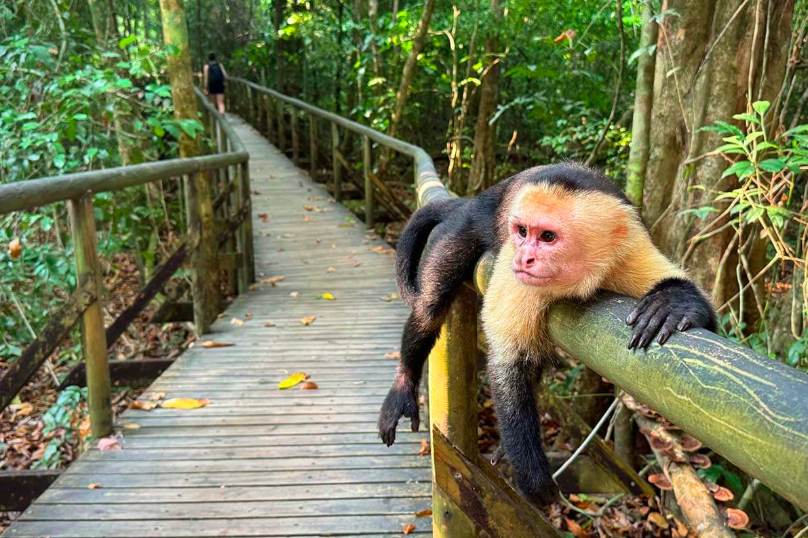Costa Rica may be small in size, but this Central American gem packs an extraordinary punch when it comes to biodiversity and natural wonders. With over 25% of its territory protected through national parks and reserves, Costa Rica stands as a global leader in conservation and sustainable tourism.
Home to nearly 5% of the world’s biodiversity despite covering just 0.03% of Earth’s surface, Costa Rica’s national parks offer visitors unparalleled opportunities to explore pristine rainforests, active volcanoes, cloud forests, and coastal ecosystems. Whether you’re seeking thrilling wildlife encounters, challenging hiking adventures, or peaceful moments surrounded by nature’s splendor, these protected areas deliver experiences that will transform your understanding of our planet’s incredible diversity.
This comprehensive guide will take you through Costa Rica’s most spectacular national parks, helping you plan an eco-conscious adventure that supports local communities while creating memories to last a lifetime. From the beaches of Manuel Antonio to the remote wilderness of Corcovado, discover where to go and what to see in this remarkable country.
Costa Rica’s Conservation Legacy
Costa Rica’s commitment to environmental protection began in the 1960s when forward-thinking leaders recognized the urgent need to preserve the country’s rapidly disappearing forests. The establishment of the National Park System in 1970 marked a turning point in global conservation efforts, creating a model that countries worldwide continue to emulate.
The park system now encompasses 28 national parks, 58 wildlife refuges, and numerous biological reserves, protecting critical habitats for over 500,000 species. This network safeguards everything from tiny poison dart frogs to massive leatherback sea turtles, ensuring future generations can witness Costa Rica’s natural heritage.
The country’s “Payments for Environmental Services” program compensates landowners for protecting forests, recognizing that healthy ecosystems provide valuable services like carbon storage, water purification, and biodiversity conservation. Your visit to these parks directly supports these vital conservation initiatives.
Understanding Costa Rica’s Diverse Ecosystems
Costa Rica’s strategic location between North and South America, combined with its varied topography, creates an astounding array of ecosystems within its compact borders. The country features twelve distinct climate zones, from tropical dry forests in the north to misty cloud forests in the mountains and lush rainforests on both coasts.
The Pacific Coast showcases dramatic transitions from mangrove swamps to pristine beaches, while the Caribbean side offers dense rainforests and coral reefs. The central mountain ranges create unique cloud forest environments where moisture-laden air creates perpetually misty conditions perfect for epiphytes, orchids, and countless endemic species.
This ecosystem diversity means that traveling just a few hours can transport you from spotting scarlet macaws in dry tropical forests to observing quetzals in cloud forests, making Costa Rica an exceptional destination for nature enthusiasts.
Manuel Antonio National Park: Where Beaches Meet Rainforest
Manuel Antonio National Park perfectly embodies Costa Rica’s ability to pack incredible diversity into small spaces. This 1,983-hectare park combines four pristine beaches with primary and secondary rainforest, creating habitat for an impressive array of wildlife within walking distance of world-class accommodations.
The park’s beaches rank among Central America’s most beautiful, with white sand coves framed by lush green forest and granite outcroppings. Playa Manuel Antonio and Playa Espadilla Sur offer excellent swimming and snorkeling opportunities, while the forest trails provide chances to spot three-toed sloths, white-faced capuchin monkeys, and over 350 bird species.
Popular hiking trails include the Cathedral Point Trail, which leads to spectacular ocean viewpoints, and the Sloth Trail, where patient observers frequently encounter these charming slow-moving mammals. The park’s accessibility makes it perfect for families, while serious wildlife photographers will find endless opportunities to capture memorable images.
Visit during early morning hours when wildlife activity peaks and temperatures remain comfortable. The park limits daily visitors to 600 people, so arriving early ensures entry and better wildlife viewing opportunities.
Corcovado National Park: Costa Rica’s Crown Jewel
National Geographic has called Corcovado National Park “the most biologically intense place on Earth,” and spending time in this remote wilderness quickly reveals why this designation fits perfectly. Located on the Osa Peninsula, Corcovado protects 54,540 hectares of primary rainforest that serves as home to jaguars, tapirs, scarlet macaws, and countless other species.
This park requires serious commitment from visitors. No day trips exist due to its remote location, and all visits require advance planning with certified guides. The experience, however, rewards adventurous travelers with wildlife encounters impossible elsewhere in Costa Rica.
Four ranger stations provide access to different sections of the park. San Pedrillo offers excellent wildlife viewing opportunities and beautiful waterfalls, while Sirena provides the most comprehensive rainforest experience with multi-day camping options. La Leona and Los Patos serve as additional entry points for ambitious hikers tackling multi-day treks.
The park’s pristine beaches stretch for miles without development, offering opportunities to observe nesting sea turtles during appropriate seasons. Inland trails wind through dense primary forest where ancient trees tower overhead and wildlife sounds create a constant symphony.
Arenal Volcano National Park: Fire, Hot Springs, and Adventure
Arenal Volcano National Park showcases Costa Rica’s volcanic origins through dramatic landscapes dominated by the iconic Arenal Volcano. While the volcano entered a resting phase in 2010 after decades of spectacular eruptions, the surrounding ecosystem continues to provide exceptional wildlife viewing and outdoor adventure opportunities.
The park’s trail system leads through both old lava flows and lush secondary forest regenerating from past volcanic activity. The Los Tucanes Trail offers excellent bird watching opportunities, while the Cecropia Trail provides chances to spot howler monkeys, coatis, and numerous tropical bird species.
The nearby Arenal Observatory Lodge area features the park’s most challenging hiking trails, including routes that approach the volcano’s base through diverse forest types. These trails reward hikers with close-up views of the volcano’s imposing cone and opportunities to observe how plant communities recover from volcanic disturbances.
Adventure activities abound in the Arenal region. Canopy zip-line tours provide thrilling perspectives of the forest canopy, while white-water rafting on nearby rivers offers exciting challenges for various skill levels. Natural hot springs heated by volcanic activity create perfect spots for relaxation after active days exploring the park.
Monteverde Cloud Forest Reserve: A Mystical Mountain Experience
The Monteverde Cloud Forest Reserve protects one of Costa Rica’s most unique and endangered ecosystems. This private reserve, established through collaboration between local Quaker settlers and Costa Rican conservationists, preserves pristine cloud forest habitat that exists nowhere else in the country.
Cloud forests form when trade winds carry moisture-laden air up mountain slopes, creating persistent fog that supports incredibly diverse plant communities. Over 2,500 plant species thrive in Monteverde’s misty environment, including hundreds of orchid species, massive strangler figs, and countless epiphytes that create hanging gardens throughout the forest.
The reserve’s trail system accommodates various fitness levels and interests. The Sendero Bosque Nuboso provides an excellent introduction to cloud forest ecology, while the more challenging Continental Divide Trail leads to viewpoints overlooking both Pacific and Caribbean watersheds on clear days.
Monteverde is famous for its incredible bird diversity, including the legendary resplendent quetzal. Over 400 bird species have been recorded here, making it a premier destination for serious birders. Early morning guided tours with experienced naturalist guides significantly increase chances of spotting rare species.
Night tours reveal a completely different aspect of cloud forest life. Nocturnal creatures emerge after dark, including various frog species, insects with remarkable adaptations, and occasionally elusive mammals like kinkajous and olingo.
Wildlife Viewing Strategies and Seasonal Considerations
Successful wildlife viewing in Costa Rica’s national parks requires understanding animal behavior patterns and seasonal variations. Most mammals and birds are most active during early morning hours when temperatures are cool and food sources are abundant. Planning park visits to begin at sunrise maximizes wildlife encounter opportunities.
The dry season (December through April) offers easier hiking conditions and clearer weather, making it popular with visitors. However, the rainy season (May through November) provides its own advantages: lusher vegetation, active bird breeding behavior, fewer crowds, and spectacular afternoon thunderstorms that create dramatic photographic opportunities.
Different parks showcase seasonal highlights. Sea turtle nesting occurs at specific times and locations: leatherbacks nest on Pacific beaches from October through March, while green turtles prefer Caribbean beaches from July through October. Quetzal breeding season in Monteverde runs from March through June, increasing chances of observing these magnificent birds.
Hiring certified naturalist guides dramatically enhances wildlife viewing success. These professionals possess intimate knowledge of animal behavior, habitat preferences, and current wildlife activity patterns. Many guides also contribute to ongoing research and conservation efforts, making your visit part of larger scientific initiatives.
Practical Planning for Your National Park Adventure
Entry fees for Costa Rica’s national parks support conservation efforts and park maintenance. Most parks charge around $15-16 for international visitors, with some variation based on park size and facilities. Annual passes provide excellent value for visitors planning to explore multiple parks during extended stays.
Accommodation options vary significantly by location. Popular areas like Manuel Antonio and Arenal offer everything from budget hostels to luxury eco-lodges, while remote locations like Corcovado require advance reservations at limited facilities. Eco-lodges throughout Costa Rica increasingly emphasize sustainable practices, supporting both conservation goals and local communities.
Transportation planning requires careful attention to Costa Rica’s road conditions and seasonal weather patterns. Many parks are accessible via public transportation, though rental vehicles provide greater flexibility for exploring multiple locations. Four-wheel-drive vehicles become essential during rainy season and for reaching remote park entrances.
Packing appropriate gear enhances comfort and safety during park visits. Sturdy hiking boots, rain gear, insect repellent, sunscreen, and plenty of water are essentials for all parks. Binoculars and cameras with telephoto lenses significantly improve wildlife observation and photography opportunities.
Supporting Conservation Through Responsible Tourism
Your visit to Costa Rica’s national parks directly supports conservation efforts, but thoughtful travel choices can maximize your positive impact. Choose accommodations and tour operators with recognized sustainability certifications, such as the Costa Rican Tourism Board’s Certification for Sustainable Tourism program.
Respect wildlife viewing guidelines by maintaining appropriate distances from animals and never attempting to feed or touch wild creatures. Stay on designated trails to minimize habitat disturbance and erosion. Pack out all trash and avoid single-use plastics whenever possible.
Support local communities by purchasing locally-made crafts, eating at locally-owned restaurants, and hiring local guides. Many rural communities depend on tourism income, and your choices can help ensure that conservation provides economic benefits to people living near protected areas.
Consider participating in citizen science projects during your visit. Many parks offer opportunities to contribute to ongoing research through activities like bird counts, wildlife monitoring, or forest restoration projects. These experiences provide deeper connections to conservation work while supporting scientific understanding of these ecosystems.
Frequently Asked Questions
What’s the best time of year to visit Costa Rica’s national parks?
Both dry season (December-April) and rainy season (May-November) offer unique advantages. Dry season provides easier hiking and clearer weather, while rainy season features lusher landscapes, fewer crowds, and active wildlife breeding behaviors. Consider your priorities and specific interests when choosing travel dates.
Do I need a guide to visit national parks?
While guides aren’t required for most parks, certified naturalist guides dramatically enhance wildlife viewing success and provide valuable educational context. Some remote areas like Corcovado National Park require guides for safety and conservation reasons.
How physically challenging are the hiking trails?
Trail difficulty varies significantly between and within parks. Most parks offer easy walks suitable for all fitness levels alongside more challenging multi-day treks. Research specific trails in advance and choose routes matching your physical capabilities and interests.
What should I pack for visiting national parks?
Essential items include sturdy hiking boots, rain gear, insect repellent, sunscreen, plenty of water, binoculars, and a camera. Specific parks may require additional gear, so research individual park recommendations before traveling.
Are Costa Rica’s national parks safe for solo travelers?
Most parks are very safe for solo travelers, though some remote areas benefit from traveling with others or hiring guides. Follow standard safety precautions, inform others of your plans, and stay on designated trails.
Preserving Paradise for Future Generations
Costa Rica’s national parks represent one of conservation’s greatest success stories, transforming a country that was rapidly losing its forests into a global model for sustainable development and biodiversity protection. Your visit supports this remarkable achievement while providing unforgettable experiences with some of Earth’s most extraordinary wildlife.
These protected areas face ongoing challenges from climate change, habitat fragmentation, and increasing visitor numbers. By choosing responsible tourism practices, supporting local communities, and spreading awareness about conservation importance, you become part of the solution.
The memories you create exploring Costa Rica’s national parks will last a lifetime, but the impact of your visit can last much longer. Every entrance fee paid, every local guide hired, and every sustainable accommodation chosen sends a powerful message that protecting natural heritage provides economic value alongside irreplaceable ecological benefits.
Plan your Costa Rica national park adventure with conservation in mind, and you’ll discover that the most meaningful travel experiences come from places where your presence helps ensure these natural wonders will inspire future generations of travelers and wildlife enthusiasts.



